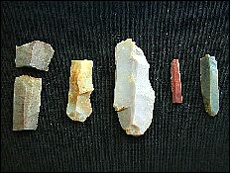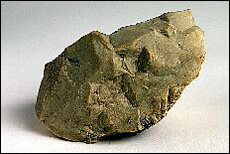
|
Flint splinters from the Stone-Age dwelling site at Saarenoja in Joutseno. The only others like this known in Finland are from the dwelling site at Ristola in Lahti. That site is about 10,600 years old and, as far as we now know, Finland's oldest dwelling site after the last Ice Age. Flint does not occur naturally in Finland's soil. It is always brought from somewhere else. The black flint at Saarenoja may have come from the southern Baltic Sea; the gray and light brown flint may be Estonian. The violet-tinted flint which predominates in the findings at Saarenoja may have come from the Valdai region of Russia. Reddish and brown flint is found in all the areas mentioned above. Picture, South Karelian Museum / Seppo Pelkonen.
|

|
|
A broken flint fragment found at a dwelling site at Kiurula in Imatra tells something about the first inhabitants of Imatra, of South Karelia, and perhaps even of all Finland. Picture, South Karelian Museum.
|
The first inhabitants
People arrived along the southern shores of the ancient bays and lakes of South Karelia's Salpausselkä chain of ridges possibly as early as 11,000 years ago, and certainly by 10,000 years ago. The inhabitants probably came from the south and the southeast. To date 16 dwelling sites have been discovered at Kiurula in Imatra and Kuurmanpohja in Joutseno, on the shore of the ancient body of water. Several of these sites are from the earliest, pioneer-phase of settlement. Finland's oldest postglacial dwelling site may be among these. Indications of the oldest pioneer settlement have also been found at Luumäki.
People moved about in the vicinity. We know this, as well as something about the way of life, from one of the world's oldest fishnets, which a fisherman lost in the mud on the bottom of the lake about 10,400 years ago. The net was discovered at the start of the century while ditching a field at Vuoksenranta in Antrea. Today the finding site is located within Russia, not very far as the crow flies from the Imatra and Joutseno settlement areas.
